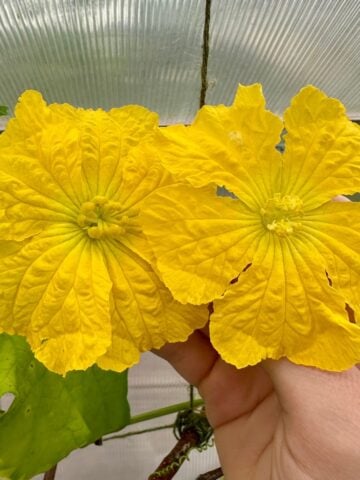Have you ever wanted to plant flowers in your garden, but don't want to "waste" the space on ornamentals. Well, safflower is an edible flower so no more "wasting" space on ornamentals! This edible flower is a great addition to your garden so continue reading to learn how to grow safflower.

| Botanical Name | Carthamus tinctorius |
| Plant Type | Annual edible flower |
| Sun Exposure | Full sun to partial shade |
| Soil Conditions | Dry soil that is porous |
| Harvest Time | 70-80 days from planting |
| Difficulty | Easy, Medium, Hard, Extreme |
What is the safflower plant
Safflower is an annual plant that resembles a thistle plant. The main difference between the thistle plant and safflower is the flower color.
Safflowers have red, orange, yellow, and sometimes white flowers while thistles usually have purple flowers.
Now I know what you are thinking, "Why would I purposely grow a plant that looks like a thistle?". Because safflower is so useful and it also looks nicer than a thistle (at least to me) that’s why.
Since this plant does have sharp thorns on it, plant it strategically. Planting them along a border is great as it will deter rabbits, deer, and other animals from eating your other garden plants.
Where should I grow safflower
Safflower does not need much moisture; in fact, they thrive when it is dry. For some climates that may sound like the perfect plant, but for others it may be a struggle to find dry soil.
If you do struggle with soggy soils, plant safflower on the highest point of your garden. I do not recommend that you plant safflower in pots because they have large tap roots that do not do well being crammed. If your soils are very wet, you may need to plant them in raised beds.
Since safflower plants do have large roots that are great at soaking up moisture do not plant them too close to moisture loving plants like tomatoes. Plant safflower closer to plants that like dry conditions for a symbiotic relationship.
Should I start my safflower plants in pots
I have been able to transplant safflower plants with okay results. They did not like being in the pot and they get root bound very quickly, so I would not recommend transplanting them.
When to plant safflower
Plant your safflower after all danger of frost has passed. Safflower is very sensitive to frost so do not plant before your last frost date. For me (zone 5) I can plant my safflower seeds towards the middle to end of May.
After you plant your safflower seeds keep the soil moist and have patience. Safflower can take a long time to emerge from the soil. The great thing about safflower is that once it sprouts it grows really fast.
After your safflower plants have established themselves you should not have to water them too much. You are more likely to over water safflower plants than under water them.
Waiting for flowers
Since safflower does not need much fertilizer it really does not need much care. All you need to do is keep the weeds pulled and wait for flowers.

To help keep the weeds at bay and build soil life I recommend mulching around your safflower plants.
Flower heads should start to form after 70-80 days from planting. Each plant can have anywhere from 3-50 flowers and may continue to bloom if the summer is long enough.
Safflower pest and diseases
Safflower does not have many pest issues because it is so full of thorns. The pests usually stay as far away from this plant as possible.
Safflower is susceptible to root rot and fungal diseases. Make sure the plants have plenty of ventilation and do not water them in the evening. Once the plants are established you really should not have to water them.
How to harvest safflower
Safflower is also known as poor mans saffron. That's right safflower is a saffron substitute. This edible flower can also be used to flavor tea, rice, and many other dishes.
**I am not a registered herbalist or medical professional and your should research all plants before you ingest them**

The part of the safflower plant that you can harvest is the flower petals, stamins, and pistils. This is just the colorful part of the flower.
To harvest them you will need to grab some thick gloves (these plants are extremely sharp), then pinch the flower tops and pull upwards to pull the centers out. You may want to hold onto the plant when you pull on them so you do not pull them out of the ground.
Preserving safflower
I like to dehydrate my safflower to preserve it. I use a counter top dehydrator and set it on the low setting (95oF).

I run the dehydrator for a few hours until the petals are completely dry. Once dehydrated you can put the safflower in a sealed jar and it will last for a few years.
What to use safflower for
Use safflower just as you would use saffron. You can substitute saffron with safflower using a 1:1 ratio.
Pin this!






Leave a Reply